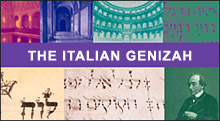
by Prof. Mauro Perani
Part 4: Content and origins of manuscripts found in book bindings
I wish to refer to the data of the Nonantola collection, one of the biggest
which has been catalogued and which can constitute a valuable example in general.
About 33% of the fragments belong to biblical manuscripts, 28% to Halakic
literature represented by the traditional Sifre Mitzwot; 15% containing biblical
commentaries, 8% Mishnah, Talmud, and other talmudic compendia, while 7% represent
philosophy and Qabbalah; 4% contain dictionaries or lexicographical works,
3% scientific texts about medicine, astronomy and geometry and, finally, 2%
liturgical texts.
A characteristic of the Italian Genizah is the heterogeneity of the origin
of the fragments. While, in fact, the fragments found in Austria and Germany
are exclusively Ashkenazic and those of the Iberian peninsula are Sefardic,
those found in Italy are partially of Italian origin (over one third), partially
Ashkenazic (about one third) and also Sefardic (less than one third). As already
pointed out, this fact reflects the waves of Hebrew immigration to Italy from
other European regions.
But let us now examine the most important findings. Over 350
sheets of the Babylonian Talmud, as well as some fragments of Talmud Yerushalmi,
of the Mishnah and of the Tosefta, were discovered in book bindings. Other
fragments have a certain importance because they preserve unpublished pieces
of the Rashi talmudic and biblical commentaries and also a Greek gloss.
In the State Archives in Pesaro the only recomposition of about
a whole manuscript (all 82 sheets) has been found: it is a French Mahzor (festival
prayerbook) in Ashkenazic writing dating back to the 12th century. The manuscript,
copied from a text written probably by a disciple of Yosef ben Yehiel from
Paris, explains the liturgical tradition used by the Jews of northeastern
France.
This is a rare document because the French Jews, expelled from
France in 1396, then adopted the liturgical traditions of the countries where
they went to live. The Pesaro Mahazor contains also piyyutim, some of which
are unknown, by French authors, among which one by Rabbenu Tam kept in very
few other manuscripts. The publication of this Mahzor[1] will provide new
information of great interest to the study of Jewish liturgy, its development
in Europe during the Middle Ages and the hymnographic knowledge of that period.
Part 1: The discovery
| Part 2: Background information
|
Part 3: Research methodology | Part
4: Content of findings
 |
[1] To be edited by Hillel
Sermoneta and Angelo Piattelli |



